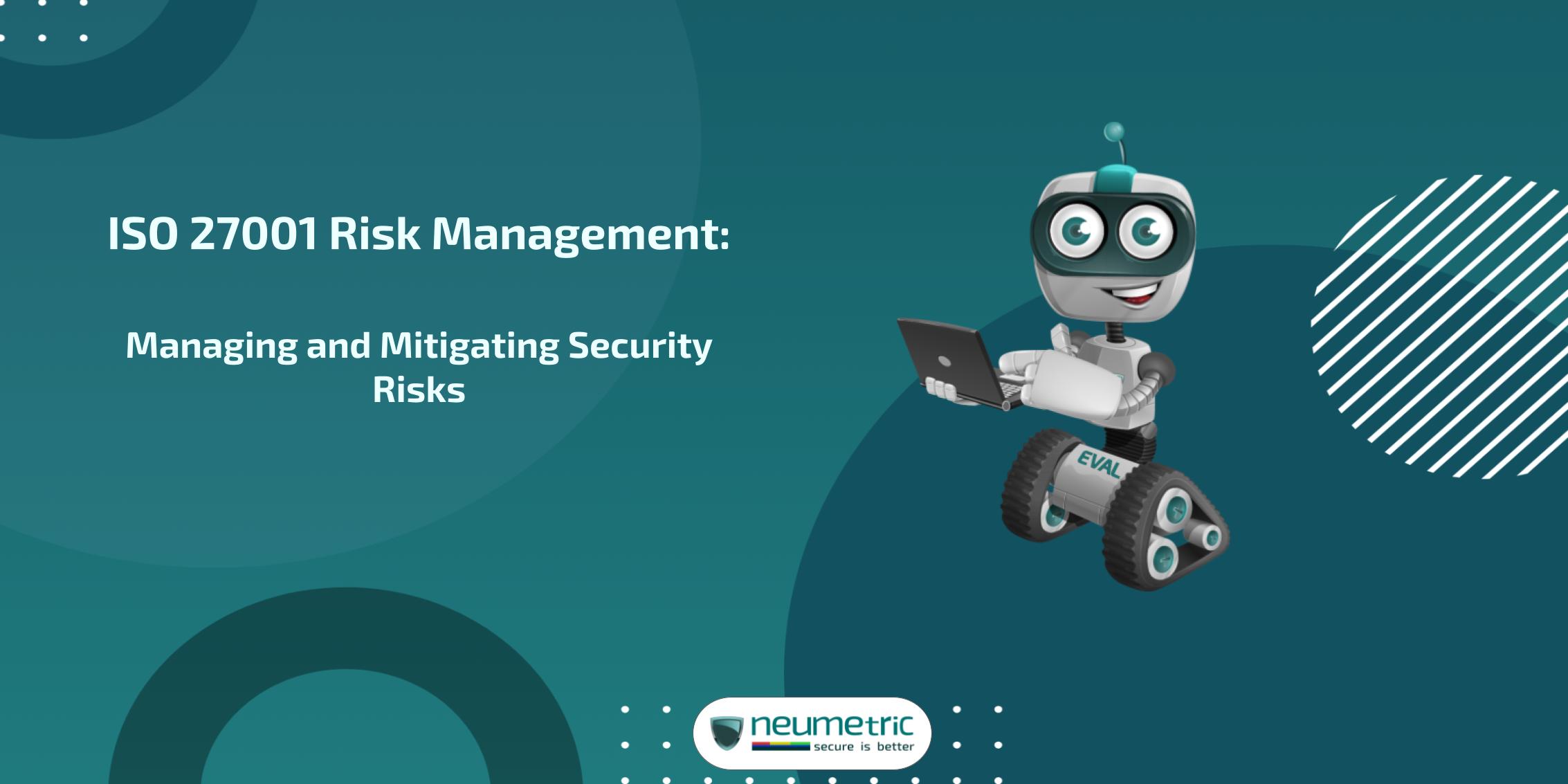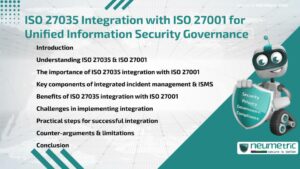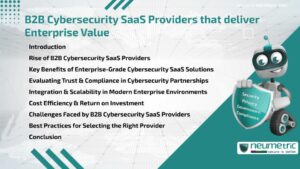Table of Contents
ToggleIntroduction
In today’s digitally-driven environment, information security has taken on critical importance for organizations worldwide. Cyber threats are continuously evolving & protecting sensitive data is more challenging than ever. A breach or data loss incident can result in substantial financial & reputational harm, making it essential for businesses to adopt effective information security standards. ISO 27001, one of the leading international standards for information security, emphasizes structured risk management to address vulnerabilities systematically.
This journal explores how ISO 27001 helps organizations implement robust risk management frameworks to manage & mitigate security risks effectively. From understanding the importance of risk management to practical applications & mitigation strategies, we will delve into each aspect in detail to provide a comprehensive understanding of ISO 27001 risk management.
The Importance of Risk Management in ISO 27001
ISO 27001 risk management offers a strategic approach to identifying & addressing information security threats, which is foundational to protecting an organization’s critical assets. Effective risk management within the ISO 27001 framework plays a significant role in maintaining the Confidentiality, Integrity & Availability [CIA] of information, commonly known as the CIA Triad. As cyber threats grow more sophisticated, businesses must adopt comprehensive strategies that protect sensitive data from unauthorized access, prevent financial losses & meet regulatory obligations. Risk management according to ISO 27001 isn’t simply a defensive mechanism; it’s a proactive approach that aligns information security with business goals, fostering trust among stakeholders, including customers, partners & regulatory bodies. It also promotes a culture of security awareness, ensuring that employees understand the critical role they play in safeguarding organizational data.
ISO 27001 Risk Management Process
ISO 27001 outlines a structured risk management process consisting of several core stages, each aimed at building an effective defense against information security threats. The process includes defining the risk management context, identifying & assessing risks & selecting appropriate treatment measures.
Context Establishment
The initial stage in ISO 27001 risk management involves defining the scope of the risk management process. This means identifying the assets that need protection, the threats that could affect them & any vulnerabilities that could be exploited. During context establishment, organizations must consider their information systems, business processes, external parties & legal or regulatory requirements. By defining this context, organizations set the stage for a more focused & effective risk management approach.
Risk Identification
Risk identification is the foundation of ISO 27001 risk management & it involves creating a comprehensive list of potential threats. Risks can come from multiple sources, including human errors, cyber threats, environmental factors & organizational weaknesses. Identifying these risks may involve brainstorming sessions, reviewing historical data, conducting interviews & consulting checklists tailored to the organization’s industry. The goal is to capture all potential vulnerabilities, both internal & external, that could threaten the organization’s information security.
Risk Assessment & Analysis
Once risks are identified, they need to be assessed based on likelihood (how probable a risk event is) & impact (the potential consequences if the risk occurs). ISO 27001 allows for either a quantitative or qualitative risk assessment approach. Quantitative assessments are based on numerical data & metrics, which can be useful for calculating the potential financial impact of risks. On the other hand, qualitative assessments are descriptive, relying on risk matrices or heat maps to prioritize risks based on severity. Organizations may use a hybrid approach, combining numerical data with visual tools to create a more comprehensive view of their risk landscape. This evaluation helps organizations prioritize high-impact risks, guiding decision-making on resource allocation.
Risk Treatment
Risk treatment involves selecting & applying appropriate strategies to manage identified risks. ISO 27001 outlines several treatment options:
- Risk Avoidance: Ceasing activities that expose the organization to unacceptable risks.
- Risk Reduction: Implementing controls to decrease the likelihood or impact of the risk.
- Risk Sharing: Transferring or sharing some risk through measures like insurance or outsourcing.
- Risk Retention: Accepting the risk when it is minimal, unavoidable or too costly to mitigate fully.
Each of these options allows organizations to address risks in a manner consistent with their risk appetite & available resources. By applying these strategies, organizations can effectively reduce their vulnerability to information security threats.
Identifying Information Security Risks
The process of identifying risks goes beyond merely listing potential threats; it also requires understanding the specific nature of each risk & its implications. Information security risks typically fall into several categories:
- Human Threats: These include risks from intentional acts, like hacking or data theft, as well as unintentional acts, such as accidental data deletion by employees.
- Technological Threats: Technological failures, such as outdated software or hardware vulnerabilities, can compromise information security if not promptly addressed.
- Environmental Threats: Natural disasters or environmental factors can jeopardize physical assets, such as servers & data storage devices, emphasizing the need for backup & disaster recovery plans.
- Organizational Threats: Risks associated with business processes, decision-making or supply chain vulnerabilities also need careful consideration.
Effective identification methods in ISO 27001 include Strengths, Weaknesses, Opportunities & Threats [SWOT] analysis, threat modeling & surveys among stakeholders. Each method provides unique insights, allowing organizations to map out a complete & precise list of risks.
Evaluating & Assessing Risks
Risk assessment, a crucial component of ISO 27001, helps organizations decide where to focus their security resources. ISO 27001 recommends that organizations conduct risk assessments to not only identify critical areas but also determine their risk priorities based on potential impact. This systematic approach helps organizations develop efficient & cost-effective security strategies.
Quantitative vs. Qualitative Risk Assessment
Quantitative & qualitative risk assessments each have their merits. Quantitative assessments use numerical data, allowing organizations to quantify risks in monetary terms. For example, a risk assessment might calculate potential losses in case of a data breach. Qualitative assessments, on the other hand, categorize risks based on descriptive scales, such as “low,” “medium,” or “high” severity. This method is often easier to communicate to stakeholders & is frequently represented through heat maps or risk matrices. By combining both approaches, organizations gain a clear understanding of their risk landscape, which aids in prioritizing high-impact risks.
Risk Mitigation Strategies
Mitigating risks effectively is at the heart of ISO 27001. This standard provides guidelines for implementing technical, procedural & physical controls to reduce the likelihood or impact of security incidents.
- Technical Controls: Cybersecurity solutions such as firewalls, encryption & intrusion detection systems can prevent unauthorized access to sensitive information.
- Procedural Controls: Implementing security policies & procedures that guide employees in secure practices reduces risks arising from human errors.
- Employee Training: Regular awareness programs educate employees about cybersecurity risks & the importance of following security protocols.
- Physical Security: Physical measures, such as restricting access to data centers, using surveillance cameras & implementing badge systems, help protect physical assets.
Implementing ISO 27001 Controls
ISO 27001 includes a list of recommended controls known as Annex A, which is divided into multiple domains that cover specific areas of information security. Key control areas include:
- Access Control: Defining who has permission to access specific resources.
- Cryptography: Ensuring data is encrypted during storage & transmission.
- Incident Management: Establishing procedures to identify & respond to security incidents swiftly.
- Compliance: Regular audits & assessments ensure adherence to ISO 27001 requirements & other legal obligations.
By implementing controls from Annex A, organizations can tailor their risk management strategies to target specific vulnerabilities, creating a strong defense against information security threats.
Continual Improvement & Monitoring
ISO 27001 encourages continual improvement in the risk management process to adapt to changes in the threat landscape & organizational structure. This improvement cycle is often implemented using the Plan-Do-Check-Act [PDCA] model:
- Plan: Identify risks, set security objectives & establish policies.
- Do: Implement policies & security controls.
- Check: Monitor & evaluate the effectiveness of these measures.
- Act: Make adjustments as necessary to improve security measures.
Continual improvement ensures that organizations are prepared for emerging threats & that security controls remain relevant & effective.
Challenges & Limitations of ISO 27001 Risk Management
Despite its comprehensive approach, ISO 27001 risk management can present challenges for organizations:
- Resource Demands: Implementing & maintaining the required controls can be resource-intensive, especially for smaller businesses.
- Complexity: Interpreting & applying ISO 27001 standards to diverse organizational structures can be challenging, requiring expertise in information security.
- Evolving Threat Landscape: New cyber threats emerge faster than organizations can adapt, posing ongoing challenges to maintain robust security.
While these limitations exist, ISO 27001 remains a powerful framework for organizations committed to information security.
Conclusion
ISO 27001 risk management is an essential framework for organizations seeking to fortify their information security practices. By emphasizing a structured, methodical approach, ISO 27001 helps organizations identify, assess & treat security risks that could compromise sensitive data. Although implementing ISO 27001 can be challenging due to resource demands & the evolving cyber threat landscape, the benefits far outweigh these obstacles.
Embracing ISO 27001 not only enhances an organization’s resilience against cyber threats but also fosters trust with clients, partners & regulatory bodies. In an era where data breaches are a constant threat, ISO 27001 risk management provides a clear path forward, ensuring that information security remains a priority for organizations of all sizes.
Key Takeaways
- ISO 27001 provides a structured approach to information security risk management.
- Risk management in ISO 27001 protects the confidentiality, integrity & availability of information.
- The ISO 27001 risk management process involves context establishment, identification, assessment & treatment of risks.
- Effective identification methods, such as SWOT analysis & threat modeling, help capture potential risks.
- Risk assessments are essential for prioritizing risks & allocating resources effectively.
- Mitigation strategies include technical, procedural & physical security controls.
- Annex A of ISO 27001 outlines specific control measures that organizations can implement.
- Continual improvement, through the PDCA model, helps adapt security measures to new risks.
- ISO 27001 controls, while resource-intensive, are instrumental in building a resilient security posture.
- Despite its limitations, ISO 27001 provides a robust foundation for managing & mitigating information security risks.
Frequently Asked Questions [FAQ]
What is ISO 27001 risk management?
ISO 27001 risk management is the process of identifying, assessing & mitigating information security risks to protect an organization’s data & systems from threats.
How often should organizations conduct ISO 27001 risk assessments?
Organizations are encouraged to conduct risk assessments regularly, at least annually or whenever there are significant changes in the organizational structure or IT environment.
What are some examples of risk treatment options in ISO 27001?
Risk treatment options include risk avoidance, risk reduction, risk sharing & risk retention.
Why is continual improvement important in ISO 27001 risk management?
Continual improvement ensures that the risk management framework adapts to new threats & organizational changes, maintaining the effectiveness of security controls.
Is ISO 27001 certification mandatory for all organizations?
No, ISO 27001 certification is not mandatory, but it is recommended for organizations seeking to enhance information security & establish credibility with stakeholders.





